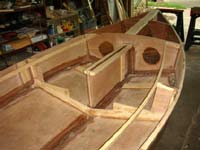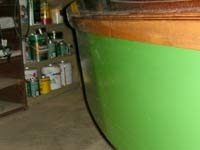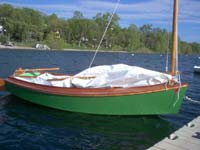|
Skat |

|
| By Peter Simmons - Minneapolis,
Minnesota - USA |
When casting about for plans for a sailboat to replace
my beloved AF3,
Lumberduck, I was taken by Jim Michalek’s Skat
design. I loved my AF3, but wanted a boat with a better
hull shape for the steep chop we often get here on
Minnesota lakes, and Skat’s deep V bottom, combined
with her broad beam and large interior volume, seemed
just right. Not to mention … the photos published
in Duckworks of Tidmarsh Major’s Alabama Skat
(see links at end of article - Chuck) were
so cool lookin’ I just had to have one. So I
sold Lumberduck to a couple of teenaged brothers for
about a quarter of what she cost to build and rig,
ordered Skat plans and started building 4th of July
Weekend in ’05.
 |
I ordered
Skat plans and started building 4th of
July Weekend in ’05.
(click
images to enlarge) |
|
This boat was going to be different from my previous
boats, I vowed. With one exception – a canoe
I built for a friend – I had always built with
lumberyard materials, but this time I invested most
of what I realized from selling Lumberduck in marine
plywood. I bought 7 sheets of jequitiba marine ply
from Wayne Meier at Midwest Marine Plywood in Eagan,
MN. Judging by the company name you’d think
this was a big outfit with lots of inventory. Actually
Wayne just sells marine ply and some other specialty
lumber out of his garage, which does, in fact, contain
a surprisingly wide and varied inventory. Wayne’s
a great guy, and was very helpful, and the price was
right.
In general, the plans were clear, as I’ve found
to be the case on all the Michalek plans I’ve
seen, and the build was straightforward, with one
exception. I joined the side panels together with
what I believe is called a “Payson Joint”
– basically, thickened epoxy for the edge joining,
with fiberglass tape on each side, filled with un-thickened
epoxy. I’d done this once before with good results,
so didn’t anticipate any problems. After two
days everything seemed cured hard and I began gluing
and screwing the sides and transom to the frames,
using thickened epoxy and SS drywall screws. Got it
all together, then watched in horror as the Payson
Joints slowly failed on both sides, the pieces hinging
inward to the tune of crackling fiberglass. I guess
I must have mixed a bad batch of epoxy for the joint.
I’d mixed the batch for the thickened epoxy
first, then mixed another batch to fill the glass.
The second batch cured hard, but underneath the glass
the first batch must have stayed soft. There was only
one thing to do … panic!
| The bad Payson
joint |

|
|
A less tightly-would builder might have unscrewed
the panels from the frame, carefully scraped and wiped
off the uncured epoxy, and learned a valuable lesson
with no harm done. Sadly, my character is forged of
sterner stuff. In my mind I now had to make butt blocks
for the joints before the epoxy I’d used to
glue the sides to the frames and transom could kick
off. I don’t know why I believed this was my
only path. This situation reminds me of the time about
20 years ago when my car stalled in a blizzard. I
got out and opened up the hood, remembered I knew
nothing about engines, then slammed the hood shut,
catching a substantial piece of my coat in it. I was
trapped. Barring intervention from a convenient Saint
Bernard, I would die there in the snow. The only way
out was the hood release lever inside the car, which
I obviously couldn’t reach. So I ended up tearing
my coat nearly in two in order to save my life. A
less tightly wound motorist, of course, would have
slipped out of his coat, released the hood, then put
his coat back on. My point is, I don’t know
if emergencies inspire me, or I inspire emergencies.
 |
Skat on
her trailer
|
|
With steely, manic precision I cut two pieces of
clear pine 1x4 for the butt-blocks, even beveling
the lower end for looks. I took my trusty belt sander
to the inside face of the failed Payson joint and
ground off the fiberglass. Then I slathered some carefully
mixed epoxy onto the 1x4 pieces and screwed them on
from the outside in--screwed the hell out of them,
because it took quite a bit of force to reinvent the
fair curve of the side panel.
Incredibly, I got away with all this, except for
two small imperfections: there is a small, but noticeable
ridge at the port joint, and the butt block on the
inside of the port joint is unaccountably crooked.
Depending on my mood, I a) don’t notice these
flaws, or b) see them as proof of my depravity. So
it goes.
| Waiting to
go sailing |

|
|
As for sailing, so far I’ve been out only once.
A less tightly wound sailor probably would have waited
for a day with milder conditions, but since one reason
I built Skat was to be able to brave a wilder set
of wind and water I said, What the hey?
It was a thrill a second, with winds around 15 mph
and gusts over twenty, but I always felt secure in
Skat. She just knifed through the waves, and came
about without complaint. Slight weather helm, just
like she's supposta, and she de-powers easily by easing
the sheet or dropping the tiller. You can't really
tell in the pics, but the chop was very steep, and
it would have knocked AF3 senseless. After taking
the picture of the boat sailing, my friend climbed
aboard with me, and the boat was even more stable
with the added ballast.
 |
Skat with
a bone in her teeth
|
|
All in all Skat feels like a big little boat with
the big-hearted temerity to stand up to the most furious
of tempests Mother Nature unleashes on the sheltered
lakes on which I sail. Anyone looking for a small,
solid boat with a great shape under the waterline
would do well to choose this design. And if you want
to ask me for tips on building … you should
have your head examined.
Peter Simmons
Minneapolis, MN

More about Skat:
|